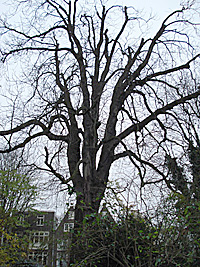By Madeleine Lowe, other
In 2006, the diseased, 150-year-old chestnut tree outside of the secret annex where Anne Frank hid during World War II was set to be cut down. In preparation for its death, saplings from the tree were promised to different sites around the world to carry the tree and its message to new communities.
Despite strong pushback from the tree’s supporters and a series of legal battles that ensued, which saved the tree and resulted in the construction of a support structure to keep it from falling, Seattle was chosen as one of the recipients.
However, on August 23, 2010, a windy day in Amsterdam, the tree fell, taking its support structure with it.
Now, with the original tree gone, the saplings sent around the world—including 11 to the U.S.—are all the more important to the tree’s supporters.
“There’s just a really wonderful feeling about having something from Amsterdam,” said Ilana Cone Kennedy, director of education at the Washington State Holocaust Education Resource Center, “something that represents this positive idea of hope in our community.”
From July 1942 to August 1944, when Anne Frank and her family were in hiding, Anne used the tree as a sign of hope and happiness until the Frank family was discovered.
Anne mentioned the tree in her world-famous diary three times.
“From my favorite spot on the floor I look up at the blue sky and the bare chestnut tree, on whose branches little raindrops shine, appearing like silver, and at the seagulls and other birds as they glide on the wind. As long as this exists, I thought, and I may live to see it, this sunshine, the cloudless skies, while this lasts I cannot be unhappy,” she wrote.
Kennedy and Maureen McNeil, director of education at the Anne Frank Center USA in New York, who recently visited Seattle, both wish for the sapling Seattle will receive to do the same for this community.
“In our proposal for the tree we talked about the shooting that happened here in 2006 and then the outpouring of support that occurred afterwards,” said Kennedy. “But the tree wasn’t really a memorial, the tree was really to remember what can happen when all of these groups come together to support each other. And we hope…for all the communities of Seattle to see that we can respect each other’s differences and how powerful that can be.”
All 11 saplings to be planted in the U.S. are currently under quarantine, as required by the U.S. government to ensure no diseases will be brought to America. However, the quarantine will end at the end of 2012, and when spring weather begins, the trees can be planted.
According to McNeil, Seattle’s sapling will most likely be planted in the spring of 2013 near the Asian Art Museum in Volunteer Park.
“We’re planning on doing a large ceremony that will be open to the community,” said Kennedy. “We’ll just make a wonderful celebration of it.”
The design for the site of the tree is still underway.
“One idea is that we’ll open it up as a contest to submit ideas for the actual planning of what the site will look like,” said Kennedy. “We hope for something organic with stones…something very natural.”
The Holocaust Center has partnered with Seattle Parks and Recreation, which will be maintaining the tree, to ensure its long and healthy life.
In addition to becoming a part of Volunteer Park, the Holocaust Center will use the tree as a way to continue informing the community about Anne Frank’s story. They will team up with The Anne Frank Center USA, which, according to Kennedy, is “a powerhouse of educational materials.”
Many community organizations will be invited to the ceremony to symbolize and facilitate community respect, including Densho, an organization that collects oral histories from Japanese-Americans placed in internment camps during World War II, the Wing Luke Museum, the Seattle Asian Art Museum, the Bosnian community and the gay and lesbian community.
Anne Frank relied on the tree outside her window to assure her that the world was still good, a sentiment that still resonates today, McNeil said.
“I think that [the tree] will be really linking a lot of contemporary American issues with historical issues in Anne Frank’s life and time,” said McNeil.
